Database of German military and paramilitary units in Greece 1941-1944/45
Project executing organisation: Institute of Historical Research/NHRF
Project start: May 2019
Funding: German Federal Foreign Office, German-Greek Future Fund
First funding period: May 2019-December 2021
Second funding period: October 2022-December 2022
Third funding period: April 2023-December 2023
Fourth funding period: June 2024-December 2024
Fifth funding period: June 2025-December 2025
Principal Investigator: Dr. Valentin Schneider, guest researcher IHR/NHRF
Supervisor: Dr. Nikolaos Papazarkadas, Director of the Institute of Historical Research/NHRF
Follow our Facebook page for the latest updates
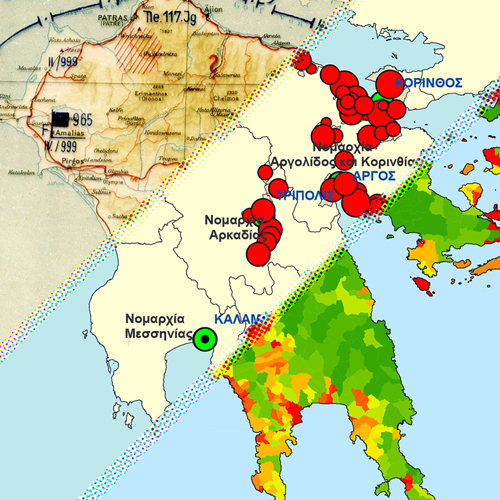
Artwork illustrating the process of transcription of historical information into digital data, using the example of the Peloponnese during the German occupation of Greece in the Second World War.
The project idea
Most of the earlier and recent studies on the German occupation of Greece during World War II focused mainly on military action, war crimes and mass violence, from persecution, arrests, torture, and concentration camps, to extermination. Although these studies have identified and highlighted a significant part of the German forces, there are still some dark areas in the related history. In practice, in terms of the total presence of occupation troops stationed in Greece during the war, the precisely located units represent only a fraction of the total numbers. Other military units are mainly characterized as “German units”, “German troops”, “German authorities” etc. However, the impact of these unknown units on the daily life of the Greek population was often just as important, for example through the requisition of houses and foodstuff, the imposition of forced labour, and other arbitrary measures.
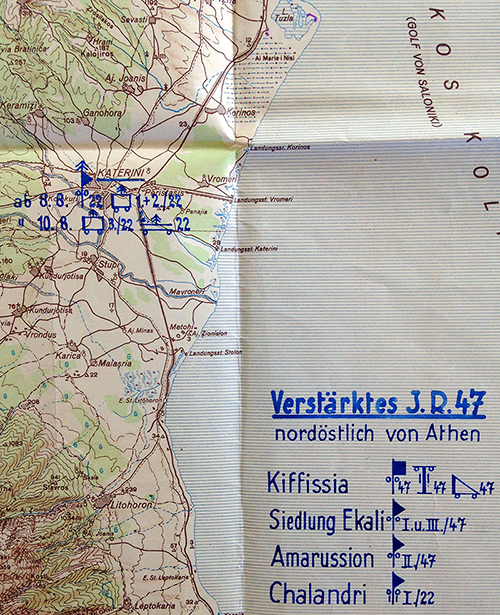
Lagenkarte Ia vom 5.8.[1942] – Verlegungen in den Raum Athen/Kreta, Bundesarchiv-Militärarchiv, RH 26-22/49, fol. 659.
Aim of the project
Considering the important place held by German occupation in the collective memory of the Greeks today, the research project “Database of German military and paramilitary units in Greece 1941-1944/45”, which is being conducted at the Institute of Historical Research of the National Hellenic Research Foundation, aims to identify and record all the German military and paramilitary units stationed for shorter or longer periods of time in Greece between April 1941, the date of the German invasion, and October 1944, the date of the retreat of the German troops (and May 1945 for some remote areas and islands).
This database will be a useful tool for deepening the historical knowledge of the period in Greece, as it will
- help to identify German units involved in war crimes,
- further specify the numerical scope of the occupying forces,
- shed light on the structure and evolution of military and paramilitary units.
Once completed, the database will be made accessible to the public and serve as a tool not only for academic research but also for local and regional history initiatives, school programs, etc.
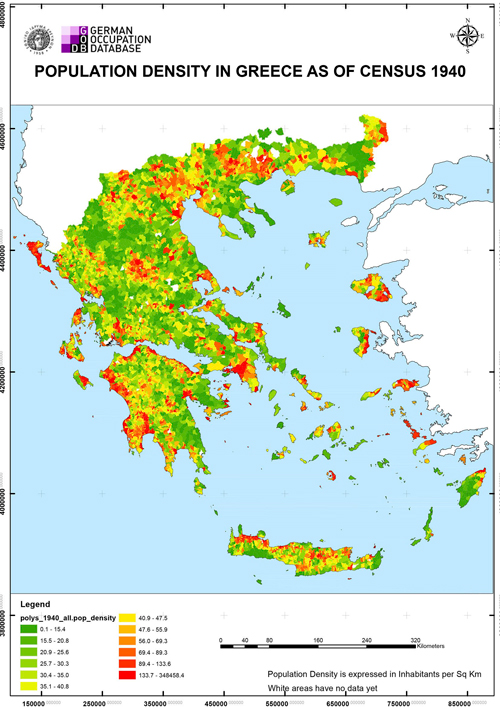
For the research project German Occupation Database, the first digital map of Greece in the administrative boundaries of 1940 (plus the Dodecanese) was created. The digital file of this map will be published at the end of 2023.
Dynamic mapping
The recorded data will be fitted into a dynamic GIS environment application (GIS: geographic information system) that will allow the visitor to make personalized use of the database, for example by searching for the itinerary of a given unit, or the evolution of the occupation density of a specific location or area in successive periods of time.
Through timecoding and geocoding of the available data, the application will also allow researchers to put qualitative data derived from other sources (for example from personal testimonies or intelligence reports of resistance organisations) into the broader context of the local structures and the evolution or movement of the occupation troops.
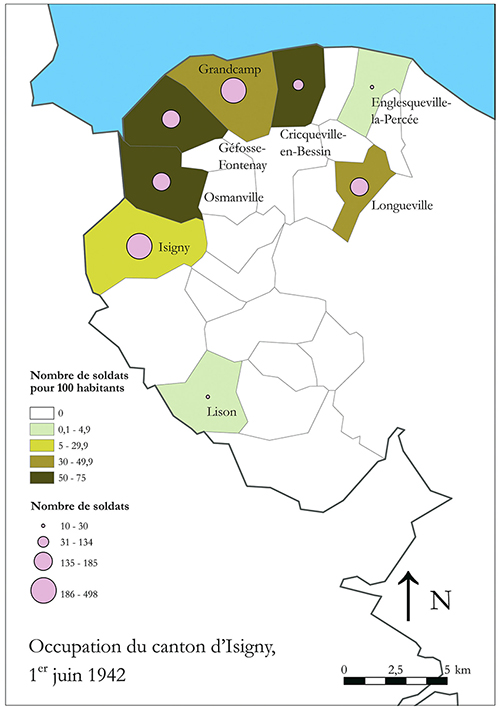
Valentin Schneider, La présence allemande en Normandie, 1940-1948 – Approche croisée d’une cohabitation franco-allemande forcée, PhD thesis, University of Caen, 2013, document no. 185, p. 1078.
Methods and sources
Various published and unpublished sources will be used to form the main structure of the database. The hierarchy of the German Wehrmacht and Waffen-SS will be scanned “from top to bottom”, from the largest structures and command authorities to the regiments and companies level. An extensive use will be made of the war diaries and their annexes of the different units, kept in the Bundesarchiv-Militärarchiv in Freiburg (and partly in the archives of the Academy of Athens). Documents relating to the losses of the units held by the former “Deutsche Dienststelle (ex-WASt)” in Berlin will be used to complete the database. Tables of military organization will then serve to precisely quantify the theoretical strength of the identified German units and put these in relation with the population numbers of the occupied areas.
More data will be drawn from local Greek archives and libraries, and especially from books and testimonies relating to local history. These documents are mainly useful because they contain information about the German units at companies level and below.
Another important source for this research is the specific knowledge of local historians and witnesses, which will help to accurately identify the different German troops. Often, this information remains unknown and unpublished.
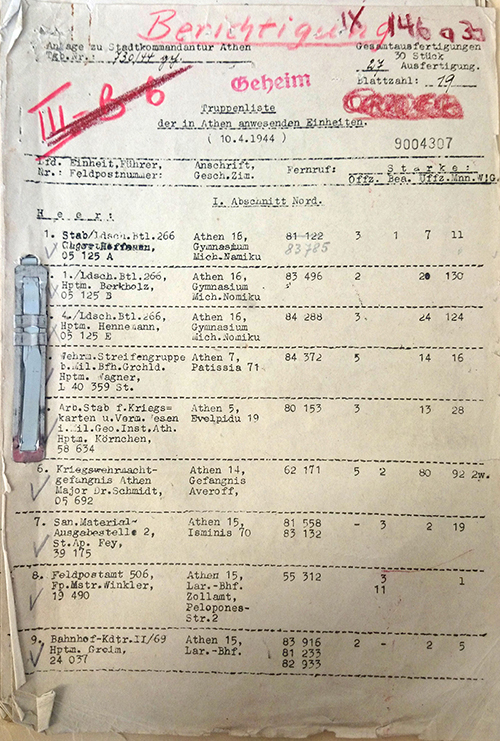
Truppenliste der in Athen anwesenden Einheiten (10.4.1944), Bundesarchiv-Militärarchiv, RH 34/263, fol. 1.
We invite anyone with relevant information, such as the names of German soldiers or local commanders or military and paramilitary units, as well as the names of vessels used by the Germans, together with the name of the occupied area and the date of the Germans’ appearance, to send us a message to the email address
These bits of information will then be compared with the data retrieved from the military archives and integrated into the database accordingly.
Funding – Duration
The realisation of the project “Database of German military and paramilitary units in Greece 1941-1944/45” is financed by the German Federal Foreign Office through funds of the German-Greek Future Fund.
The project started in May 2019.
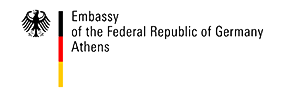
The research team
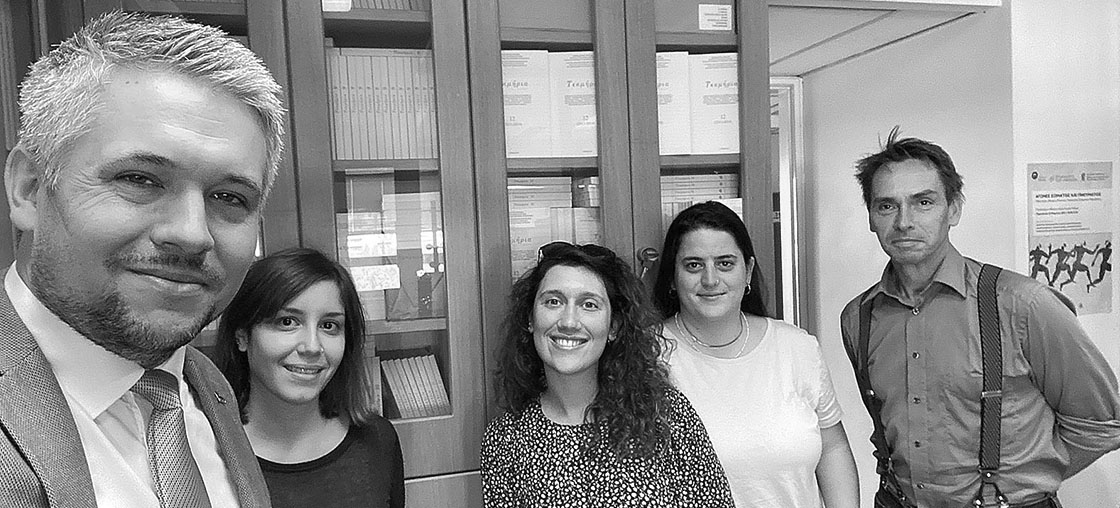

Dr. Valentin Schneider
Principal Investigator – email: [email protected]
Valentin Schneider holds a PhD in History (Université de Caen, 2013) and a PhD in Politics & International Relations (University of Nottingham, 2016). He specializes in the everyday life in Europe during and after the Second World War and is an expert on military occupation, war captivity and burial culture. His research in France led him to consider the German occupation also from a quantitative perspective. He has curated various exhibitions for institutional organizations in France and is the author of several books.
More information: www.valentinschneider.eu

Anastasia Chartomatsidi
Research associate – email: [email protected]
Anastasia Chartomatsidi was born in Athens in 1991. She is a PhD candidate in Modern Greek History at the Department of History and Archaeology of the National and Kapodistrian University of Athens. She received her Master’s Degree in International History from the London School of Economics and Political Science, where she completed her thesis entitled “The British left’s attitude towards the events in Greece between the December Events (Dekemvriana 1944) and the signing of the Varkiza Agreement (February 1945)”. Her research interests are Modern Greek History and European History.

Natalia Tsourma
Research associate – email: [email protected]
Natalia Tsourma was born in Athens in 1993. She is a PhD candidate in Modern and Contemporary Greek History at the Department of History and Archaeology of the National and Kapodistrian University of Athens. She has completed her postgraduate studies in Modern and Contemporary Greek History at the same department (2019). She has been involved in the programs "Oral Histories: The Fix Building" of the National Museum of Contemporary Art and "Memories of Occupied Greece" organized by the Free University of Berlin and the National and Kapodistrian University of Athens. Her research interests include the history of the 20th century, the history of crime and forensics, and the history of urban space.

Elli Strongyli
Research associate – email: [email protected]
Elli Strongyli, born in 1992 in Athens, graduated from the National Technical University of Athens, Department of Applied Mathematics and Physics. Her interest then turned to the Science of History, continuing her studies at the postgraduate level in Modern and Contemporary History at Panteion University. Her interests focus on the issue of the national formation of the Balkan states in the late 19th and early 20th century, the history of World War II and the history of socialism.

Raik Stolzenberg
Research associate – email: [email protected]
Raik Stolzenberg holds a Master's degree in Modern German Literature and obtained his PhD from the University of Trier in 2021 with the thesis "Art Protection as Alibi. On the Political-Military History of German Archaeology in Greece (1909-1937)". This is the first part of a monograph on the "art protection" of the German Wehrmacht in occupied Greece. Most recently, in April 2022, his article "Samos between the Fronts" was published in a volume of the Berlin State Museum, documenting thefts of excavation finds on the island for the benefit of the Berlin museums. Previously, he worked in Berlin for many years as a project developer for various cultural institutions and as a dramatic advisor for a theater.

Lukas Hennies
External collaborator – email: [email protected]
Lukas Hennies, M.A. is a member of the Department for Modern History and Historical Migration Research at the University of Osnabrück and holds a PhD scholarship granted by the Hans Böckler Foundation. His work focuses on conflict and historical migration research in the 20th century and the development of digital methods with the aim to process, model and evaluate historical big data. Most recently, he worked on the historical card index of the Geheime Staatspolizei Osnabrück and on an interactive web map showing the movement and trajectories of Displaced Persons (DPs).
More information: https://www.geschichte.uni-osnabrueck.de/hennies_lukas/profil.html

George Chalaris
External collaborator – email: [email protected]
George Chalaris is a senior Geoinformation analyst and programmer. He graduated as a Dipl. Engineer from the National Technical University of Athens (NTUA) and has more than 35 years of expertise in GIS technology. Among his positions, he acted as head of the database department and head of the geoinformatics division within the Hellenic Military Geographical Service (HMGS). His research interests are web geoportals design, spatial analysis methods, development and implementation of large-scale spatial data infrastructures (SDIs), Geodatabases, as well as uncertainty handling and application of fuzzy logic methods in Geodatabase analysis.

Dr. Nikolaos Papazarkadas
Director of the Institute of Historical Research/NHRF, Supervisor on behalf of the IHR/NHRF (2023-2024) – email: [email protected]
Curriculum vitae: http://www.eie.gr/nhrf/institutes/ihr/cvs/cv_PapazrakadasNikolaos_en.pdf

Dr. Maria Christina Chatziioannou
Research Director Emerita, Supervisor on behalf of the IHR/NHRF (2021-2022) – email: [email protected]
Curriculum vitae: http://www.eie.gr/nhrf/institutes/inr/cvs/cv-chatziioannou-en.pdf

Dr. Leonidas Kallivretakis
Research Director Emeritus, Supervisor on behalf of the IHR/NHRF (2019-2020) – email: [email protected]
Curriculum vitae: http://www.eie.gr/nhrf/institutes/inr/cvs/cv-kallivretakis-en.pdf
Contact
For any questions about the project “Database of German military and paramilitary units in Greece 1941-1944/45” or if you would like to contribute with personal information, please write to: [email protected]
Links
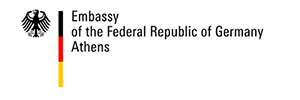
German-Greek Future Fund
https://griechenland.diplo.de/gr-de/themen/kultur/zukunftsfonds

Embassy of the Federal Republic of Germany in Athens

Osnabrück University, IMIS – Institute for Migration Studies and Intercultural Studies

Institute of Historical Research of the National Hellenic Research Foundation
http://www.eie.gr/nhrf/institutes/ihr/index-en_IHR_about.html

The National Centre for Social Research (ΕΚΚΕ)

General Staff of the Army / Army History Directorate




